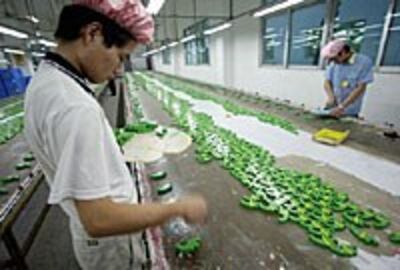
China has been harming the health of its own workers as well as children in foreign countries by using lead in manufactured toys, experts say.
For the past three months, China’s toy industry has been plagued by a series of safety problems, forcing U.S. importers to order massive recalls of dangerous products due to contamination with lead.
Most of the defects have resulted from the use of lead paint, which can cause brain damage and learning disabilities in children, according to health experts.
The first trouble came in June with the recall of 1.5 million Thomas & Friends toy trains sold by U.S.-based RC2 Corporation after coatings applied in China were found to contain high levels of lead.
More problems followed with the discovery of lead paint in Chinese-made toys imported by the leading manufacturer Mattel. In August, the company recalled 1.5 million Fisher-Price toys after finding “excessive levels” of lead.
Lead use ‘hard to stamp out’
Mattel later announced a second recall of some 19 million Chinese-made products that included dangerous magnets and lead paint. And on September 4, the company recalled nearly 1 million more toys because of lead paint used by Chinese contractors.
In an interview with Radio Free Asia, Jeffrey Weidenhamer—chairman of the chemistry department at Ohio’s Ashland University—said that Chinese manufacturers’ use of lead in children’s items has been hard to stamp out.
“Clearly, there are a lot of economic pressures on manufacturing in China. Lead is a cheap material, and scrap sources of lead are likely to be even cheaper,” Weidenhamer said.
“In [Chinese] jewelry items that we’ve tested, lead adds weight to these items. It’s attractive. It’s been used in producing costume jewelry for hundreds and thousands of years. What we now know, however, about lead is the neurotoxic effects—particularly to young kids—occur at very low doses. That’s the hazard of these items.”
Risk to workers
Weidenhamer said that lead and lead paint pose a health risk to workers as well as to consumers.
“Lead is toxic to adults as well as children, although the toxic threshold for kids is much lower. Adults who ingest large quantities of lead can be poisoned by it,” Weidenhamer said.
The precise health effects of lead on Chinese workers may be hard to determine, because symptoms may take years to emerge. Weidenhamer said that even with children, neurological damage and learning disabilities may appear long after exposure at an early age.
Jennifer Turner, director of the China Environment Forum at the Woodrow Wilson International Center for Scholars in Washington, said international companies that contract for production in China are starting to raise concerns about the entire chain of effects, including worker health and safety.
“I think it’s long overdue. When you can really shine light on how bad the situation is, it also underscores the seriousness of China’s environmental pollution, that it’s not just all about us,” Turner said.
‘Poor’ local conditions?
Turner added that Chinese manufacturers’ attempts to cut costs because of low profit margins may often be the result of poor local conditions.
“A lot of times the reason that companies’ profits are so margin-thin is because of local corruption, how much various people have to be paid off. It is true that there are some factories that are barely making it, but I think a lot of times it’s that they have to pay a lot of bribes or they have to pay a lot of money to the local economy in the form of taxes.”
China competes successfully with foreign manufacturers because of low labor costs, and using cheap but harmful materials like lead may be another way that China competes. But Turner said that dangerous or defective products will cost China more in the long run.
“Ultimately, all these cost advantages mean nothing if you start having your products banned, and millions and millions of dollars [are] lost in recalls.”
Original reporting by Michael Lelyveld. Edited for the Web by Richard Finney.
